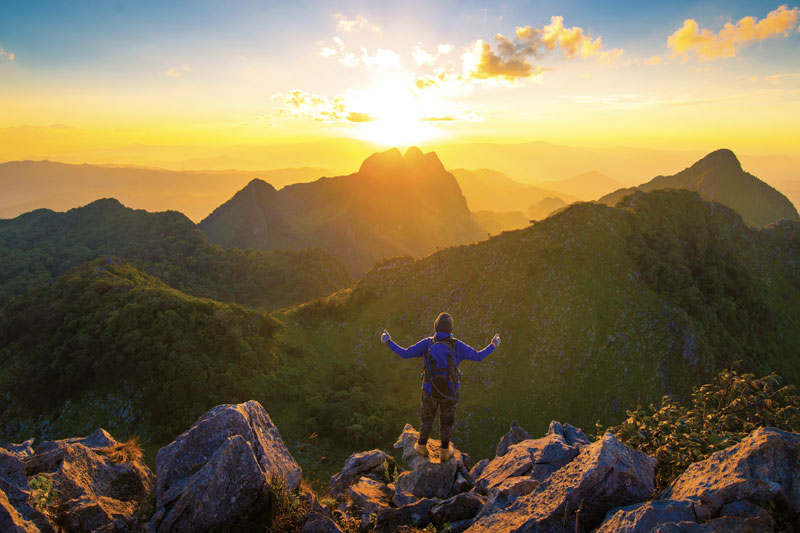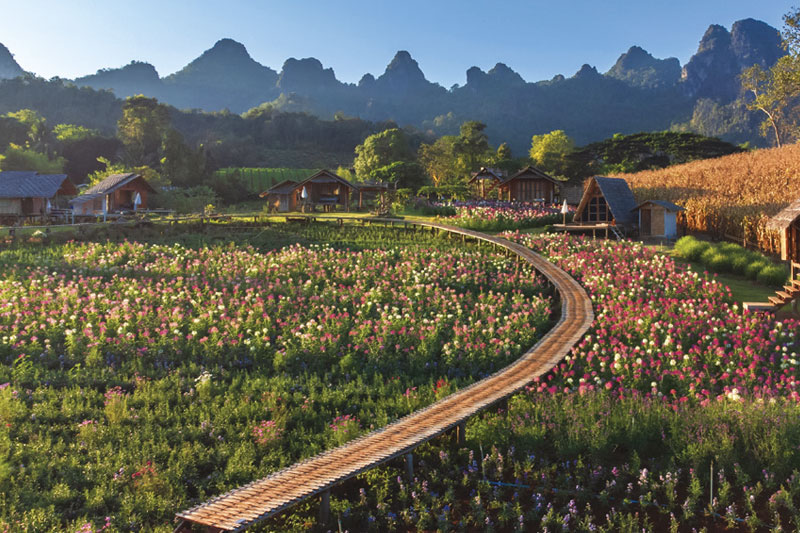
Conquering Doi Luang Chiang Dao
The 16-km hike to the summit of ‘Star’ mountain and back in one of Thailand’s most memorable experience
Words & Photos: Ron Emmons
I’m not the sort of person who climbs a mountain just because it’s there, but there were plenty of reasons why I longed to stand on top of Doi Luang Chiang Dao in North Thailand. Located just 70 kilometres north of Chiang Mai, it may be only the third-highest peak in Thailand at 2,225m (Doi Inthanon and Doi Pha Hom Pok are first and second), but it is certainly the kingdom’s most dramatic mountain. Its massive limestone bulk rises almost sheer from the rice paddies that surround it, and its slopes are so steep that it appears impossible to climb from many angles.
The Chiang Dao range, which comprises several peaks over 2,000m high arranged in the shape of a horseshoe, is home to many rare species of animals, birds and plants. Along with the great views and glimpses of nature’s rarities, I guessed the two-day trek (one day up, one down) would be good exercise as well as a welcome break from emails and work.
A friend, Mike, decided to join me so we arranged our permits, porter and guide and began early one misty morning in December. We started walking from a rangers’ outpost about halfway up the mountain, which still left over a thousand metres of elevation to climb to the summit. We set off at a steady pace with Tam, our guide, stopping frequently to point out unusual wildflowers and distant birds. The trail was gentle at first, following the contour of a hillside and across a ridge, passing between towering pines which gave off an intoxicatingly fresh scent, and drawing us up into the valley ringed by majestic peaks.
Then gradually the track began to get steeper. I needed to be surefooted; in some places the drop-offs were so steep that one slip could be fatal, and my stamina was often tested by knee- or waist-high steps up jagged rocks. Unusually for the time of year, the sky was overcast, which made the climb a bit more comfortable, but also dampened the drama of the peaks around us.
Though we didn’t see any of the rare birds we had been told to watch out for, such as the Giant Nuthatch and Hume’s Pheasant, many wildflowers were in bloom, ranging from sunflowers to delicate orchids. One tree found only in this region is the grandiosely named trachycarpus oreophilus, a fan palm which somehow grows on almost vertical slopes and otherwise barren ridges, giving the impression of hair bristles on the mountain’s head.
The Thai names of many wildflowers that Tam pointed out to us end with the suffix “chiang dao”, which means “star city” (“doi luang” means “great mountain”), and it seemed an odd coincidence that many of their blossoms also formed a star pattern.
The real challenge came after we had been walking for about four hours, as the path began to climb ever more steeply towards the top of Doi Luang, the highest peak in the range. My legs already felt like jelly and finding the effort to keep going was getting tougher every step of the way. However, by taking frequent breaks and pushing myself on, I finally made it to the rudimentary campsite about 200 metres below the summit, where Mike and our helpers grinned to see the pained look on my face.
After setting up camp and relaxing for a while, Tam suggested trekking to the summit for a panoramic view of the range. The horribly steep track was daunting, but this last half-hour climb revealed a host of different plants such as rhododendrons, as well as an endearing encounter with a small owl, unlike any creature I had ever seen before. Its camouflage was perfect, and without Tam’s sharp eyes, I would surely have missed this memorable sight. Tam also pointed out a long-tailed goral (a type of mountain goat) that was foraging on the precipitous slope of a nearby peak.
As we stepped on to the summit, the clouds that had blanketed the sky all day magically evaporated, and the breathtaking view of lofty pinnacles instantly made all the effort of getting there worthwhile. I rattled off shots with my camera in every direction as the sun slid towards the horizon, then all too quickly it was time to descend before dark.
The sense of achievement had me glowing, but the temperature quickly plummeted to around 5°C, and after a simple meal Mike and I bundled ourselves into our sleeping bags in the tent. When Tam called us at around 5am to go and watch the sunrise from an east-facing peak, I was eager to warm myself up with more climbing. Sadly, the sea of mist in the valley we hoped to view from on high had swept up the mountain and swirled damply around us, revealing little more than glimpses of tiny houses and trees way below in the Chiang Dao valley and shafts of sunlight trying to break through.
I was feeling smug as we broke camp and began the long clamber down, thinking that it was all downhill from here. But then disaster struck. The heel of my right boot came flapping off, and I panicked, imagining the torture of scrambling over eight kilometres of razor-sharp limestone rocks barefoot. No sooner had I strapped it up temporarily than the heel of my left boot flapped loose too.
From then on, I had to stop frequently to re-strap my heels, but to my huge relief the boots held together until we got back to the trailhead. Apart from this worry, the return trek was a real treat, with soft sunlight bringing to life the peaks that had stood in sombre shade the day before.
As we bumped back down the mountain in the pick-up, Tam suggested we might enjoy a soak in the hot springs in his village, Ban Yang Por To, at the foot of the mountain range. Mike and I both raised our eyebrows in delight at this idea, and half an hour later, our expedition ended in memorable fashion. We sat in the steaming hot tubs, letting the minerals work wonders on our aching joints and muscles as we gazed up at the imposing mountain we had now conquered, and started hatching a plan to take on Thailand’s second- highest peak – Doi Pha Hom Pok near Fang.

Visiting the Chiang Dao Biosphere
Since the Chiang Dao Wildlife Sanctuary was declared a biosphere in 2021, regulations have tightened, which means this delicate ecosystem is better protected – but also more difficult for visitors to access. It is open to the public only from November 1 until February 28 each year and there is a limit of 100 people per day. Visitors need to book on the Sanctuary’s Facebook page (https://www.facebook. com/profile.php?id=100064346786079; phone +66 (0) 53 456 623) and commit to a three-day stay: one for briefing, one to go up the mountain and one to go down. The inclusive fee is 1,000 baht. Due to the mountain’s increasing popularity and limited window of opportunity, bookings often close well before the end of the season.
